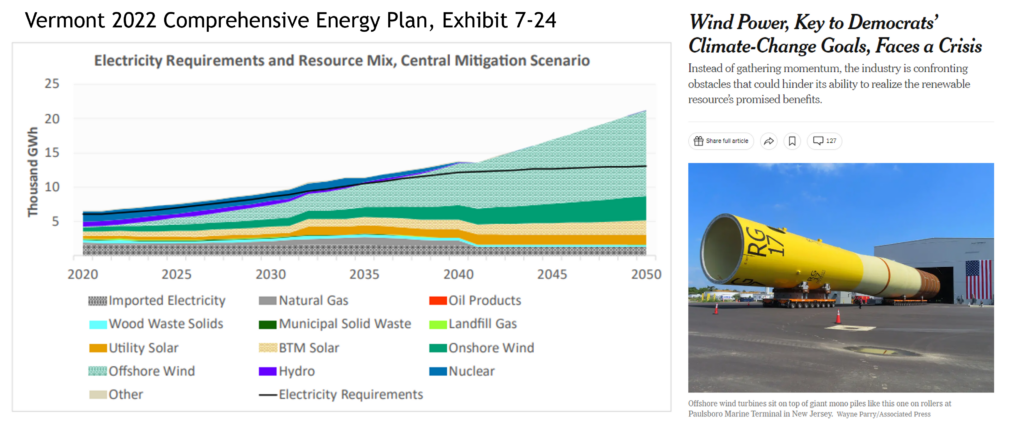The news over the past few weeks that the offshore wind industry is struggling has shined a stark light on the assumptions in Vermont’s Comprehensive Energy Plan. In 2022, the Vermont Department of Public Service outlined a “Central Mitigation Scenario” that envisioned Vermont utilities purchasing a rapidly increasing share of their power from offshore wind. The Department asserted this scenario was the most cost-effective one that it modeled, and offered significant savings relative to prioritizing more in-state renewables (2022 CEP, pg 260-261). Less than two years later, as the offshore wind industry grapples with rising costs, the Department’s preferred vision of how we get our power looks increasingly unrealistic.
As shown in Exhibit 7-24 of the Plan, the Department’s Central Mitigation Scenario envisioned that Vermont utilities would be purchasing offshore wind power today (they are not) and that these purchases would rise to approximately 2,000 GWh by 2030. Recent reporting by the New York Times and others strongly suggests that this 2030 vision is unachievable.

Offshore wind projects will have an important role to plan in our long-term energy future, but the projects thus far have been incredibly difficult to permit and build and several contracted projects have already been canceled or are in significant danger of cancelation. As the Times reports:
“An assortment of recent obstacles to projects in New York, New Jersey and Connecticut are almost certain to delay — and possibly derail — Northeastern states’ grand ambitions to harness the winds blowing over the Atlantic Ocean.
Four projects that were supposed to provide electricity to New York City and its suburbs are in limbo after being denied big increases in subsidies. And on Tuesday, the world’s biggest developer of offshore wind farms shocked New Jersey officials by backing out of two projects off the state’s southern coast. “Macroeconomic factors” including inflation and rising interest rates had made the projects too expensive, the company said.”
The power from any wind projects that are built in this decade is likely to go to states like New York, Massachusetts, Connecticut, and Rhode Island that have statutory targets for wind development.
So if offshore wind is off the table in the near term, how does Vermont meet its climate goals?
The answer is to accelerate the deployment of the kind of renewable energy projects that we have the most control over – namely in-state wind, solar, and storage. Updating the Renewable Energy Standard to require utilities to get 20% of their power from Tier II sources would go a long way toward filling the gap left by canceled and delayed offshore wind projects – covering nearly 40% of the missing off-shore wind energy from small, predominately solar projects. Building new wind projects in Vermont and upgrading older wind sites with more modern, more efficient turbines would help too (the Department did not consider expanding Vermont’s wind capacity in the Comprehensive Energy Plan). Doing so would require revisiting the state’s strictest-in-the-nation-wind sound rule and replacing it with a science-based rule, but help us close the rest of the gap.
Ultimately, as the Comprehensive Energy Plan correctly predicts, it will take new renewables from both in and out of state to meet our climate goals. But with offshore wind in tumult, the balance will need to shift considerably further towards Vermont-based resources
